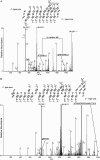Identification and origin of N-linked β-D-N-acetylglucosamine monosaccharide modifications on Arabidopsis proteins
- PMID: 23144189
- PMCID: PMC3532274
- DOI: 10.1104/pp.112.208900
Identification and origin of N-linked β-D-N-acetylglucosamine monosaccharide modifications on Arabidopsis proteins
Abstract
Many plant proteins are modified with N-linked oligosaccharides at asparagine-X-serine/threonine sites during transit through the endoplasmic reticulum and the Golgi. We have identified a number of Arabidopsis (Arabidopsis thaliana) proteins with modifications consisting of an N-linked N-acetyl-D-glucosamine monosaccharide (N-GlcNAc). Electron transfer dissociation mass spectrometry analysis of peptides bearing this modification mapped the modification to asparagine-X-serine/threonine sites on proteins that are predicted to transit through the endoplasmic reticulum and Golgi. A mass labeling method was developed and used to study N-GlcNAc modification of two thioglucoside glucohydrolases (myrosinases), TGG1 and TGG2 (for thioglucoside glucohydrolase). These myrosinases are also modified with high-mannose (Man)-type glycans. We found that N-GlcNAc and high-Man-type glycans can occur at the same site. It has been hypothesized that N-GlcNAc modifications are generated when endo-β-N-acetylglucosaminidase (ENGase) cleaves N-linked glycans. We examined the effects of mutations affecting the two known Arabidopsis ENGases on N-GlcNAc modification of myrosinase and found that modification of TGG2 was greatly reduced in one of the single mutants and absent in the double mutant. Surprisingly, N-GlcNAc modification of TGG1 was not affected in any of the mutants. These data support the hypothesis that ENGases hydrolyze high-Man glycans to produce some of the N-GlcNAc modifications but also suggest that some N-GlcNAc modifications are generated by another mechanism. Since N-GlcNAc modification was detected at only one site on each myrosinase, the production of the N-GlcNAc modification may be regulated.
Figures






References
Publication types
MeSH terms
Substances
Grants and funding
LinkOut - more resources
Full Text Sources
Molecular Biology Databases

